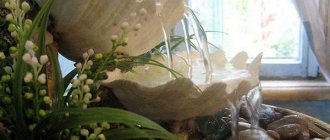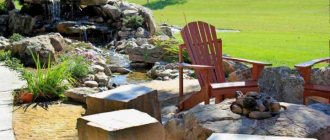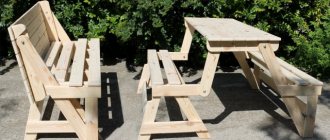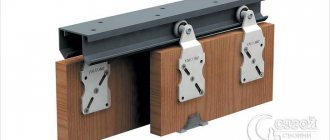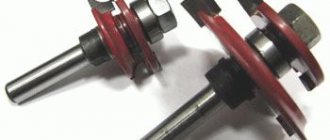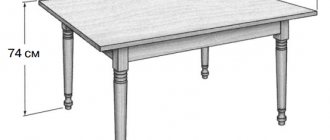Hi all! Today we have an unusual topic, since we will talk about a home fountain with our own hands. Not every person even thinks about such an interior element.
But in reality, organizing a fountain at home will be very original, beautiful and sometimes useful.
Organizing an indoor waterfall for your home or apartment is not as difficult as it might initially seem. It can be homemade, collected from shells or bottles, or ready-made from the manufacturer.
It’s worth noting right away that this is a decorative waterfall, the purpose of which is to decorate the room. Additionally, the pleasant sounds of water make it possible to relax and calm down.
What do you need to prepare for work?
In order to make your own fountain from improvised materials, you need to prepare a number of basic components:
- A reservoir into which water will flow in the future.
- Waterproof glue.
- Decorative elements.
- Silicone pipes.
- Pump.
We must not forget about the selection of the main element - a special pump. It is impossible to say unequivocally which device is better to purchase, because everything is individual and depends on the wishes of a particular person. The required pump power varies depending on the desired height of water lift. A universal option is a high-power pump with a regulator. To do this, you can use an aquarium pump to filter the water.
Home mini fountain
How to make a fountain without pumps and generators, using the simplest materials at hand:
- self-tapping screws;
- drill;
- plastic tubes of different diameters (this point is especially important, as you can learn from the article on the eternal fountain);
- sealant or glue;
- ordinary plastic bottles - 2 or 3 pcs.
The diagram shows the structure of the future design, in which it is important to maintain the distance and length of the tubes inside the vessel. Such a fountain will work on the principle of squeezing out water and air by the liquid’s own weight.
Note! The tightness must also be 100%.
Assembly method
At the very beginning, of course, you need to prepare the tank. To avoid problems in the future, it should be quite roomy. It is advisable to try to leave extra space that can be decorated in the future. This is much better than wiping the water off the table and throwing away the unsuccessful product. The depth of the reservoir must be sufficient to completely submerge the pump in water. A good material for making a homemade fountain is to use two ceramic pots as a base.
To do this you need:
- Prepare 2 ceramic pots and 5 trays. In the center of the large and small pallets you need to drill a hole for the pipes, and then cover all the items with waterproof varnish. You can also make several cuts along the edges of the pallets, which will ensure beautiful drainage of water.
- Install a pump at the bottom of the created tank and cover it with a pot, then pull the tubes out through the hole.
- Nearby you need to install a slightly smaller pot, on which another tray will find its place.
- The next tier is 2 more pallets, which will be arranged in decreasing order. It is important that the holes in the trays are positioned correctly and allow water to flow from one to the other.
- After assembling the main structure, you can safely decorate the fountain with various stones and shells.
Decor options for a country or garden fountain
After installing the main elements, you can begin the final part. The improvement of the reservoir and design ideas depend only on the personal preferences of the owner and his capabilities.
You can decorate an object with both living moisture-loving plants and artificial elements made from natural materials. Stone and clay figurines are often used as decoration; if size allows, small sculptures are used.
Another way to decorate is to arrange a fountain with lighting. For this purpose, lamps protected from water are used, as well as floating lamps or light strips.
There are several basic details that you need to pay attention to when decorating a pond:
- if a finished object made of polystone is installed, no additional decorations will be required;
- when using natural stones, you can choose both large cobblestones and small pebbles (unprocessed samples with sprouted moss look more natural);
- When decorating with stones, more than two rocks are not used at the same time;
- aquatic plants are placed on the water;
- Decorative grottoes can be used for decoration.
Pros and cons of creating
A decorative fountain is primarily an element designed to decorate the surrounding space. It has several key advantages:
- Bright and elegant appearance. The fountain will transform and refresh any design, perhaps becoming its main element.
- The fountain will do an excellent job as a source of coolness and will be able to maintain fresh air in any place where you install it.
- Falling water is a very beautiful action. The sight of a seething stream or streams of water rushing down promotes relaxation and helps to distract from bad thoughts. Additionally, the sounds of water allow you to achieve harmony and unity with nature.
- If you choose the right location, a fountain can help give your area a complete look. Such structures can help hide unattractive objects, for example, utility rooms.
But artificial fountains also have certain disadvantages:
- The need for special care and periodic monitoring. This structure must be cleaned regularly to prevent debris from clogging the pump. It is also necessary to monitor the serviceability of the equipment and promptly resolve any problems that arise.
- Given that the pump requires electrical power to operate, the fountain will incur certain costs to operate, which can be particularly high if the installation will be in operation for a long time.
A fountain is an interesting addition to the site
If there is a pond with a waterfall on the site, then this beautiful composition can be supplemented with a fountain. This type of fountain is called submersible , and its installation does not require much effort.
First you need to select a nozzle for supplying a water jet. In specialized stores you can find a variety of nozzles for throwing out a jet: geysers, domes, hemispheres and others. Also, along with the nozzle, you can take additional equipment that will illuminate the water in the evening.
The shape of the fountain jet depends on the type of nozzle.
By connecting the nozzle to the pump you get a finished fountain.
Also, stationary fountains, which represent a ready-made figure, are used to decorate the site.
When choosing a place on the site for a fountain, you should pay attention to whether it is possible to connect to power.
The fountain should be placed in open areas so that it can be seen from any point and can always please the eye.
Budget options for creating a fountain:
1. Using an old tire you can create a beautiful small waterfall that will look great in any garden.
The tire is cut approximately in half along its plane and laid on its side. The deep part serves as a frame for the pond. A hole is dug, which will be slightly larger than the tire. The tire is placed tightly in the dug hole and compacted well.
Next, spread the film over the entire surface of the frame, and its edges are tucked over the sides of the tire. An important feature is that you should not deepen the tire so that soil does not get into it.
The next step is to decorate the tire with beautiful natural or artificial stones. The stone is laid on cement mortar. Next, install a small pump with a fountain attachment in the pond and pour water.
2. You can get an interesting fountain using an old bathtub . The principle of its installation is identical to that of a tire. A special pump and a nozzle are placed inside the bathtub, from which a stream of water will be ejected. The installed bathtub is decorated with natural stones and decorative vegetation.
3. Another budget option for a fountain is made from an ordinary plastic bottle . To do this, take a plastic bottle, clear it of all labels, and use the heated end of a wire or awl to make holes throughout the bottle. The number of holes depends on how many jets of water you need to receive.
Next, connect a hose to the neck of the bottle and secure it with a clamp or tape. The fountain is ready, you can turn on the water. This fountain is great for entertaining children, and also refreshes the area in hot weather.
Shapes and sizes
Although the fountain can have any size and shape, when choosing them it is recommended to use common sense and remember that it will be somewhat more difficult to care for an installation with a more intricate shape and large dimensions.
The bowl of the fountain can have a symmetrical or non-standard asymmetrical shape. For example, it can be made in the form of an oval, square, circle, triangle, as well as any other geometric shapes, including those that follow the contours of the silhouette of an animal or a person.
Also, fountains can be complex multi-level or made of several interconnected containers. In this case, each element can be equipped with its own nozzle, being an integral part of a more complex installation.
How to make Heron's fountain: what can be improved
They say that there is no limit to perfection, and almost any thing can be modernized ad infinitum - this is not entirely true, but nevertheless, the possibility of improving any product is almost always available. The Fountain of Heron is no exception in this regard - there are many things that can be modernized in it.
The very first thing is to increase the flow of water. We have already said above that it depends on the distance between the upper and lower containers - you yourself understand that it may not be possible to increase this distance to infinity (or at least until the necessary moment).
There is one trick here - if you correctly pair two such systems of containers and tubes, then at least the height of the jet will double. In general, you will need not one, but two bottles full of water and two equally empty ones, connected to each other by tubes in series - a full, empty, then full again and again empty jar. Full cans on top, empty cans on the bottom – it won’t work any other way.
In general, despite the fact that in general Heron’s fountain is a very well-thought-out product, there is still room for its improvement and, apparently, there is no limit to this place. To conclude the topic, it remains to add that according to the principle described above, it is possible to produce quite a lot of different systems, ranging from small experimental models of fountains to huge working models.
With the latter, however, the problem of recharging arises, which is very, very difficult to solve without a pump or other ingenious modern devices.
Stylistic design
Fountains used for decorative purposes can be made in a wide variety of styles. Whether a design belongs to one direction or another depends on various factors - appearance, shape and size, material of manufacture.
There are several design options applicable to decorative fountains:
- Classic option. The installation can be made in the form of an asymmetrical bowl made of ceramic, plaster or stone with a stream of water falling in the shape of a bell or jet.
- Fountain in English style. In such designs, the bowl has a non-standard shape and is necessarily supplemented with stucco.
- The design is in the form of a sculpture with gilding or decorated with bronze elements, made according to all the rules of such colorful styles as Baroque or Rococo.
- Installation in eco-style. This fountain is made in the form of a natural waterfall, giving it the most natural look. An installation that is a container buried in the ground complete with a nozzle disguised with stones, associated with a rock from which streams of water fall down, can best cope with this role.
- Country style fountain. A structure made from an ordinary wooden barrel or cart will be an excellent decoration for a personal garden.
- As part of the Provence style, you can use romantic sculptures made in the form of angels or sophisticated girls. Moreover, the sculpture can be specially made slightly flaky or cracked, which will give it a special flavor.
Schemes of fountains of different configurations and photos of their design
Surely you know that the main component of a fountain is its bowl. In essence, this is the same pond, but with additional equipment - a pump. A pond can be made in at least a dozen different ways, and some of them are described in a separate article, because we won’t describe how to make a bowl for a pool. We will pay maximum attention to the organization of fountains and their decor.
Small fountain
The device requires a container and a pump. Decoration is put on the tube that comes from the pump. These can be slabs of stone in which it is necessary to drill a hole, with a diameter slightly larger than the diameter of the pipe. These slabs are strung on top of each other like a children's pyramid.
Scheme of organizing a decorative fountain for a summer residence
To avoid water overflow, it is necessary to provide a drainage system - just below the maximum level, cut a pipe into the container, the second edge of which is led into the sewer system, drainage system or into the garden. You can do it another way: arrange a water collector around the bowl - make a concrete groove or dig in a plastic one. The collected water should also be taken somewhere. Usually in closed systems the problem is not overflow, but a lack of water - it evaporates, but you can play it safe.
DIY fountain: photo report 1
And now a photo report of how a mini-fountain was made with your own hands according to this scheme. It turned out interesting.
This decorative fountain took several hours to create.
To make this fountain you needed:
- square plastic flowerpot without holes;
- small fountain pump;
- a plastic pipe 0.7 m long, the diameter is such that it fits over the pump outlet;
- a bag of decorative pebbles;
- three bricks;
- red granite sawn into slabs.
The tool used is a drilling machine to drill holes in granite with a diameter slightly larger than the diameter of the pipe.
Installing a fountain container
We install a bowl in the prepared hole and place bricks in it, closer to the edges. They are needed for the stability of the structure and to reduce the amount of pebbles. They also serve as support for the stone structure. Between the installed bricks we place a pump with a tube on, pour in water and check how it works.
Holes were pre-drilled in the slabs in the workshop. They should be located approximately in the center so that the weight of the stones does not overturn the structure.
Folding the fountain
The first slab rests on lying bricks, the rest are strung so that the center of gravity does not shift. Having laid the first one, we fill the remaining space with pebbles. After the last piece is laid, a mark is made on the pipe. The very last stone is removed, the pipe is cut down just below the mark, then the last fragment is returned to its place. When the water is turned on, it seems to come straight out of the stone. Very unusual and uncomplicated.
Photo report 2
The next version of a small fountain is made according to the same principle, only a flexible hose is used instead of a pipe, and driftwood is used instead of a stone. The effect was simply wonderful.
Making a small fountain with your own hands
Everything is so clear that there is no need for comments. It differs from the previous design only in the presence of a mesh. This is to increase the volume of water: the tray is small in size.
Fountain decoration
Until you see it, it’s hard to imagine how easy it is to make amazingly beautiful things. As for pipes, it is better to use polyethylene pipes - they bend well and are not afraid of ultraviolet radiation.
How to make a fountain from a tire, see the video report.
Room or tabletop
Mini-fountains are made according to the same principle, only they use very low-power pumps. Suitable even for aquariums, but without aeration. They even work almost silently. We will make a fountain in the Japanese style. In addition to the pump, you will need a small ceramic container for this. In our case, oval made of baked clay. A piece of bamboo - about 70 cm long (bought at a flower shop, sold as a support for climbing plants), a bunch of living growing bamboo and a number of small pebbles. From all this comes such beauty.
Do-it-yourself home mini fountain
First of all, cut a piece of bamboo into pieces of different lengths. It is hollow inside - these are natural pipes, which also do not rot for a long time. One of the sides should have an oblique cut, the other should have an even cut. You cut it so that the longest piece near the evenly cut end has a “joint”. The lower incision goes approximately 5 mm below this thickening. There is simply a partition inside, with its help it will be easy to attach this segment to the pump outlet. It is difficult to cut, but I managed to saw through the thin trunk with a metal blade.
We cut bamboo into three pieces of different lengths
We put a small pump in the vessel, put the longest piece of bamboo on it - its length is about 35 cm. On the other side we put a bunch of living bamboo, filling the space between them with pebbles.
Filling the mini fountain
We tie the two remaining pieces of dry bamboo to our “pipe”. You can use hemp rope. That's all, we made a mini fountain with our own hands. All that remains is to add water and turn on the pump.
Other models can be made using the same principle. Now you understand how and it will be easy to change the design. A few photos for inspiration.
Another indoor bamboo fountain in Japanese style
Outdoor fountain made of granite bowl and bamboo
Another type, more traditional and familiar to us, uses almost the same idea and the same tools. The difference is in the design. You can take a large ceramic or even plastic pot. It is only important that it has no holes for drainage. Then it’s a matter of technique: divide it with a plastic partition into two or three zones, pour more soil into one and plant one of the moisture-loving plants.
How to make a mini fountain
The second part will be the reservoir. Only when organizing circulation is multi-stage filtration necessary: the water becomes very contaminated. Therefore, glasses made of filter materials with different meshes are inserted one after another - first - a wire or plastic mesh, then - fabric with different meshes, and inside this structure - a small pump.
Tabletop mini fountain
You can make with your own hands not only the composition of such a tabletop fountain, but also a pump. How? Watch the video.
Pebble fountain
The fountains with pebbles have a very interesting design. Their bowl is disguised, so it looks like a dry fountain, without a bowl. In fact, there is a bowl, but it is decorated with pebbles, which are laid on a mesh covering the tank.
Dry pebble fountain - device diagram
A container is installed in the dug pit. Its volume and size should be quite decent: to collect all the splashes, or at least most of them. Place a pump in the container and cover the top with a metal or plastic mesh with a fine mesh. It serves to protect against large contaminants getting into the water, and a thick wire mesh can be laid on top of this fine mesh. This is if you use pebbles. If you are laying stone slabs, you can use boards or bars.
How to make a “dry” fountain with your own hands
With pebbles, it’s probably better to do the opposite: first lay a mesh with a large cell as a base, and on top of it with a small one. This way you won’t have to worry about choosing large pebbles, and debris won’t get into the water.
Rockery with a source - this is what this fountain might look like
This option is more suitable for decorating a garden in a modern style.
If you use your imagination, you can come up with very interesting compositions based on this. For example, one of the options with a garden watering can. If your garden is decorated in a classic style, a watering can fountain is unlikely to fit well, but it will fit very well into a country style.
Watering can garden fountain
As you can see, water is collected in the same vessel, hidden under pebbles, and from there it is pumped into a watering can with a small pump.
Near the wall
This is a classic option - a small or large stream of water runs from the wall, flowing into the bowl. As you may have guessed, there is a pump in the bowl that supplies water through a pipe to the water outlet point. It's simple if you know how. It's just a matter of implementation and decoration.
Scheme of organizing a waterfall near the wall
To prevent the pump from floating, it is screwed to some kind of heavy plate. At least for the sidewalk, as long as the size fits. The case usually has corresponding holes for mounting, but when choosing, you should pay attention to this.
Classic design of wall fountain
If you plan to do something similar near the wall of a house or fence, take care of its waterproofing. Even if the water does not flow down the wall, splashes will fall on it and the humidity will be increased. At a minimum, it is necessary to coat it several times with a hydrophobic compound. Try to find one that doesn't change the color of the surface too much.
Another option for a fountain against the wall
The design style may be different. A flat surface is made at the top bowl, from which water flows off like a wall. The effect is very interesting. It is important that the surface from which the water falls is mirror-smooth and absolutely horizontal.
Beautiful fountain for a garden in a minimalist or modern style
Fountain-cascade
The iridescent jets look very interesting. Fountains of this type are called cascades or cascading. With this organization, water is poured from one bowl to another. In the case of a country or garden fountain, you can come up with interesting shapes. For example, a fountain made from buckets, watering cans, teapots and even old garden carts.
Fountain cascade of garden carts
The principle of organizing such a cascade is simple: several vessels or bowls mounted above each other so that a stream of water flows from one to the other. At the bottom is the largest tank, where the pump is located. He delivers water through a hose to the highest of the vessels.
Another decorative garden fountain
Installation location
In order for a decorative fountain to successfully cope with its role, it is necessary to correctly approach the location of its placement.
- It is advisable to choose a prominent place for the fountain so that it is clearly visible from all sides, otherwise such an installation will lose all decorative meaning.
- It is recommended to choose an elevated location for the fountain, otherwise water will accumulate and stagnate in the bowl.
- Try to install the fountain in an area where it will be protected from direct sunlight, which can cause flowering and the associated green tint and unpleasant odor.
- Don't place the fountain too close to trees if you don't want their leaves to fall into the bowl and clog the pump.
Heron's fountain - recirculation system without electricity
Heron of Alexandria was a Greek mechanic and mathematician who lived in the second half of the 1st century AD. This scientist is placed on a par with the most brilliant inventors of mankind in its entire history.
The engineer's inventions include: the first automatic doors, a self-loading crossbow, a steam turbine, the first odometer and much, much more.
This inventor was noted for the creation of many devices that work with water. The famous fountain without a pump also belongs to them.
DIY decorative fountain
It is not necessary to pay money to a craftsman to make an original decorative fountain. Any owner can handle this task independently.
Materials and tools
And first of all, you need to prepare the tools, materials and devices necessary for the work:
- container that you will use as a bowl. This could be an old barrel or a bathtub. The main thing is that the product is strong enough without damage to withstand the volume of water;
- a pipe or a sufficiently strong and dense hose for supplying water;
- pumping unit;
- materials for waterproofing;
- filter;
- nozzle;
- shovel.
Manufacturing process
Once you have everything you need prepared, you can proceed to making a decorative fountain:
- The process begins with digging a pit, which must correspond to the size of the selected container.
- The bottom of the pit must be filled with sand in a layer of 10-15 cm, and then thoroughly compacted.
- Place the bowl in the prepared recess so that its edges protrude 2-3 cm above ground level. Place waterproofing material on top of the container to prevent leakage.
- Now you need to install pumping equipment, a filter for water purification and a nozzle to obtain a jet of the required pressure and shape.
- Remove the wire from the water and connect the installation to the electrical network.
- Turn on the equipment and check the fountain in operation. All errors identified at this stage must be corrected immediately.
The fountain you make will last longer if you regularly check the condition of the devices and promptly eliminate any malfunctions that arise, as well as clean the bowl of any debris that gets into it.
A decorative fountain can become one of the main elements of your site and change its design for the better. You just need to approach its production correctly. With a little imagination and using unnecessary materials, you can certainly create a creation with your own hands that will look no worse than products made by professional craftsmen.
While landscaping their backyards, some owners at some point realize that there is not enough fountain on their property. You shouldn’t give up on this idea if you have everything planned out long ago and there is no extra space left. After all, it doesn’t have to be a large structure. Even in small areas you can find a place to arrange a compact decorative fountain, which will give you coolness and become a wonderful relaxation area.
If you decide to create it yourself, then you need to thoroughly prepare for this work. And first of all, you must understand what type of installation this installation should have, what material it should be made of, and how water should flow in it. These and many other factors will determine whether you will be satisfied with the end result.
If this is your first time making your own fountain at your dacha, then you should not build a complex configuration installation. This will not only require more time, money and effort from you to create it, but will also create certain difficulties for you in the future during care. It is best to build a small fountain of a standard shape, which can be made from the most common materials and which will not be more difficult to care for than any other object on your site.
How to make water flow without outside interference
If you attended school physics lessons, you should already have an idea of what force is easier to make something move. Of course, we are talking about gravity or, in other words, the force of gravity.
To activate it, the item must be raised to a certain height and released. The same thing happens with water. If the tank with it is raised above the ground and the cap is opened, it will flow out after some time.
Gravity will be the initial engine that will launch our fountain.
Go ahead:
- We now attach a tube to our hypothetical container that will go down - there we will direct the water strictly to a certain point.
- If this tube at the bottom is bent upward, then water will begin to fly out of it with pressure. This is, in principle, the simplest structure of a fountain.
- The higher the water tank rises, and the wider the diameter of the pipe, the stronger the pressure will be. Pressure in this case is expressed in the height of the water column.
- In a similar way, you can organize a fountain for your dacha if there is some source from which the main container will be constantly replenished.
- For example, you can use a stream. In this case, in addition to supply, you should also worry about drainage.
Since streams will not be found in every area, and even the terrain features may not correspond, it is not worth considering this method of constructing a fountain.
But you can also use other sources to fill the tank - the same summer water supply. However, somewhere far away, water is also pumped into it by pumping equipment.
So how can you make a constantly running fountain without a pump?
For this, gravity alone is not enough. The solution to the problem lies in its combined action with pressure. The ancient fountain of Heron works on this principle.
Let's create a decorative indoor fountain with our own hands for the joy of the whole family
Every year, millions of people spend huge amounts of money to visit exotic places on the planet. You can recreate natural beauty in miniature by making a decorative indoor fountain with your own hands. The lively murmur of water has a beneficial effect on a person’s emotional state. Moreover, it is impossible to take your eyes off her.
The design not only gives the room a luxurious look, but also humidifies the air during the hot season. To create a decorative indoor fountain with your own hands, it is not necessary to purchase expensive installations. The main thing is to be patient, use your imagination, pick up the tools and create miracles. First, let's look inside the structure to understand how it works. Then we will get acquainted with the types of indoor fountains. And finally, let's look at step-by-step instructions for creating a natural miniature for your home.
The fountain is not only a decorative element. Since it wonderfully humidifies the air, it should not be installed near wooden furniture.
Varieties
Before we talk step by step about the features of organizing this or that, you need to understand the types of home fountains.
They can be divided into 2 large categories:
- With pump
. Allows forced circulation of water. The device is extremely simple, reliable and efficient in operation. Pumps can differ in power, size, and produce different pressures. Here you will need to use a submersible pump. Choose the brand at your discretion. But a better option is one that works from the network; - Without pump
. On YouTube and on thematic forums you can find options for installing fountains without pumps in an apartment or house. Only here the design will be open. The downside is that then you will need to connect a pipe from the water supply to the fountain.
Yes, it could be a small fountain, some kind of mini-structure, or a more massive option, installed not on the table, but in the middle of the room, for example.
Tabletop and floor fountains can also be divided into several types, which are determined by the characteristics of water flow.
- Waterfall
. The most popular solution. Here the water flows neatly and elegantly from top to bottom; - Cascade
. Here too there is a movement from top to bottom. Only additionally there are several thresholds; - Classic
. This is the case when the water shoots up. Not the best option for indoor placement; - Stream or lake
. Beautiful, but more suitable for country houses and local areas. Rarely placed indoors.
What to choose from this variety, everyone will decide for themselves.
Before you make your own home fountain with your own hands, be sure to look at photos of different options, videos about their manufacture, and also read our material. Here we will give some recommendations so that the craft will pleasantly please you not only with its appearance, but also with its practicality.
Why does water flow
“All rivers flow into the sea, but it does not overflow.” This is what it says in the most ancient book of humanity. We see confirmation of these words every day when snow or rain falls from the sky to the ground. The Great Designer launched the water cycle in nature. Imitating him, experienced craftsmen created with their own hands a decorative indoor fountain that pleases the heart all year round. How does this system work?
Care and maintenance rules
We have already understood how the fountain works, based on the required equipment, but we should not forget that the fountain needs to be periodically looked after and serviced. To avoid equipment breakdowns and other problems, you need to follow a few simple rules:
- regardless of the type of tank (concrete, metal, plastic), you need to regularly check it for integrity;
- change the water in the bowl as it gets dirty (if there is a filtration system, this can be done less often);
- chemical cleaning agents are effective, but can harm plants or fish (if present);
- maintaining an optimal water level (in reservoirs with a closed system it quickly evaporates);
- before the onset of cold weather, the water is drained, and the structure is dismantled and sent to a place protected from moisture and frost;
- the tank itself is covered with a protective film (if cracks are detected, additional treatment will be required).
How to create a decorative indoor fountain with your own hands: step-by-step instructions
Before you get started, you need to think about the size and location where the structure will be installed. For example, it is inappropriate to place a huge fountain in a small room. And, conversely, in a spacious room, a miniature structure may go unnoticed. The decorative fountain is installed on the floor, wall or table. Much depends on the overall design of the room and the number of household members.
Depending on the movement of water, fountains are:
- Cascade - liquid falls along decorative steps or ledges.
- Closed - water moves in flasks or flat containers attached to the wall.
- Fountaining - the stream is directed upward, after which it falls into a miniature pool.
There are backlit options in the form of wall paintings that create a unique atmosphere in the room.
When choosing a location for the structure, you should take small children and pets into account. The main thing is that the structure does not disturb anyone.
But how to make a fountain at home with your own hands to fill it with exquisite exoticism.
Of course, you first need to understand how the structure works, and then collect the necessary items:
- suitable container;
- aquarium pump;
- flexible hose;
- waterproof glue;
- decorative elements (expanded clay, shells of various sizes, colored soil, wood, ceramic products);
- backlight (optional).
A vessel of any shape is suitable as a main bowl. The main thing is that water does not leak out of it. The upper part of the pump for a small fountain is equipped with a sprinkler. Since the dimensions of the structure are very small, there is no need to put on the tip. Otherwise, water will flood the surrounding area of the room.
It is quite possible to construct a miniature pump yourself, since the unit has a relatively low power.
Let's start the creative process
Those “who despise the day of humble beginnings” never achieve success. Therefore, having collected the necessary tools and materials for the construction, the wise guys get down to business.
Let's consider a traditional master class on creating an indoor fountain with your own hands at home:
- A piece of about 10 cm is cut from a suitable hose (can be an aquarium hose). Its diameter should coincide with the tip of the pump.
- A pump is attached to the bottom of the tank using suction cups and connected to the tube.
- The resulting space is filled with expanded clay or stones, placing a tube between them.
- To give the fountain a presentable appearance, all elements of the device are carefully masked using all kinds of shells, pebbles or glass.
- Depending on the preferences and interior of the room, the design of the structure is carried out using various objects.
Necessary equipment
Designing fountains involves selecting the required equipment and future location. Much depends on the area of the site, the relief textures, and other features (garden fountain: cascading, jet, etc.).
Whatever type of object is planned, several basic details will be required for its construction:
- water tank;
- nozzle;
- fountain pump.
To construct the structure, you can purchase a ready-made container. It can be plastic, metal, stone. It is also possible to build a reservoir directly on the ground.
Next, you need to decide on the power of the pump and how the jet forms a pattern. The type of nozzles used and the height to which the water will rise will depend on the desired picture.
The pump can be surface or submersible. In the first case, it is located outside the boundaries of the reservoir, which makes access easier if repairs are required. In the second case, the equipment is installed under water.
It is also necessary to take into account the planned performance of the device:
- to create jets about 50 cm high, a pump that pumps up to 850 liters per hour will be sufficient;
- in order for the water to rise up to 100 cm, the productivity must be 2 thousand liters;
- a pump pumping 3-5 thousand liters per hour will create jets with a height of 1.5 to 2 m;
- the most powerful equipment (8 thousand liters per hour) raises water up to 3 m in height.
Other technical elements include a filtration system. It clears the water of small debris and prevents it from blooming. The fountain lamp is already a decorative object.
Stylish exoticism in the interior of the bedroom
A small tabletop fountain can be made from a flower pot with a diameter of approximately 25 cm.
To work you will need:
- durable container;
- pump;
- translucent balls or pebbles;
- aquarium plants;
- paints for painting on ceramics or glass.
A flower pot is used for the base of the fountain. To give the structure a stylish look, the container is painted with special waterproof paints. To circulate the liquid, install a pump, make a hole and bring the tube up.
The bottom of the fountain is decorated with decorative balls, shells or pebbles. After filling the system with water, aquarium plants are placed inside. They give the design an exotic look and uniqueness. A simple design creation scheme opens up wide opportunities for beginning craftsmen.
A stream gurgles in a fountain and without a pump
Perhaps only a few have seen natural geysers in all their glory. As you know, there are no pumps there and no electricity. But such a release of water causes unprecedented admiration. Of course, it is impossible to create such a phenomenon at home without electricity. However, there is a way out!
To build a miniature fountain without a pump, use:
- several containers;
- thin tubes;
- connecting adapters;
- sealant (if containers are made of plastic);
- decorative elements.
First of all, drill a small hole at the bottom of each bowl. Thin tubes are pulled through them, and then sealed with cold welding. The procedure will protect the system from fluid loss.
The container used for the base of the fountain must contain the entire volume of liquid used. Several holes are also made in it for the adapter and tubes connecting the higher vessels. Since the system operates without a pump, the lower bowl must be removable to return the liquid to its original position. The final touch is the decorative decoration. For this, artificial plants (vines), transparent balls, seashells, glass and pebbles are used.
Photo selection of indoor fountains
Practice shows that maintaining mini fountains is quite simple. To do this, you need to regulate the level of liquid in the system, since it tends to evaporate. It is important that the pump is always under water. Otherwise, there will come a time when the pleasant murmur stops and the device fails. Let the water flow like a spring for happiness in every home.
Sources:
https://www.asusfone.ru/svoimi-rukami/samodelnyj-komnatnyj-fontanchik-iz-podruchnyh-materialov https://sotka.guru/dachnye-sooruzheniya/izgotovlenie-dekorativnogo-fontana-dlya-doma-svoimi-rukami .html https://glav-dacha.ru/dekorativnyy-komnatnyy-fontan-svoimi-rukami/
A fountain that works itself from plastic bottles
The classic design of Heron's fountain is described in 7th grade physics textbooks and consists of 3 containers of water, located one above the other and connected by three tubes.
For a home experiment, empty plastic bottles of mineral water or soda are perfect.
The first tube comes out of the top bowl and goes down to the very bottom of the structure. The second, which is attached separately from the first, comes out of the lower container, enters the middle one and reaches almost to the very top. The third tube comes from the bottom of the middle bowl and enters the top bowl.
- By default, all the liquid is in the middle container. In order for the fountain to start working, you need to add a little water to the upper bowl - then the liquid will automatically flow through the first tube into the lower container until it is completely filled.
- At this time, the air pressure will increase, which will be transmitted through the second tube to the middle tank.
- At the same time, pressure will also be applied to the water, as a result of which it will begin to rise through the third tube into the upper bowl and flow upward. By completing this standard physics assignment, you will be able to replicate the experience of the great Greek mathematician and inventor Heron of Alexandria.
- Another important point that you definitely need to pay attention to is the tightness of the connections. For this reason, after completing assembly, fill the entry points of the tubes in the covers with hot glue or sealant.
If you don't have sealant on hand, you can use regular plasticine as an alternative, but keep in mind that leakage is possible in this case.
